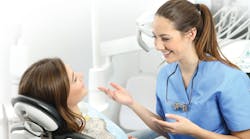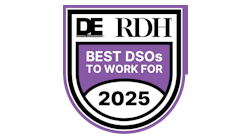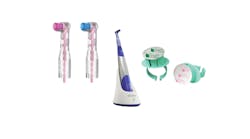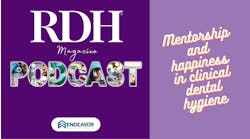Scale. Spit. Polish. Spit. Exam. X-rays. Next!
No, we must take time to educate.
The landscape of dentistry is rapidly changing in this new age of uncertainty brought on by the COVID-19 pandemic. When we return to our dental offices, the conversations we will have with our patients will transform from nonessential banter to essential treatment protocols to increase their health. This connection we will have with our patients may begin to shift their mindset from disease reaction to proactive disease prevention. Finally, it is time to forgo sugarcoated diagnoses and be real.
Dentistry has the potential to evolve from providing dental surgery to emphasizing complete health. We can promote the health of our patients by detecting signs of disease that could shorten the quality of their lives if not acted upon. Merging the worlds of dentistry and medicine is the inevitable next step in creating preventive health plans for our patients and enhancing our careers. It’s time to put down the scaler, take off our loupes, and talk to patients about how we can help them achieve health.
The dental and medical worlds have almost always been looked upon as two separate entities. We have data that proves oral conditions can contribute to heart disease, uncontrolled diabetes, erectile dysfunction, pregnancy complications, Alzheimer’s disease, various cancers, irritable bowel syndrome, and many more conditions. If we would look beyond the oral cavities of our patients and see their mouths as gateways to the rest of the body, just imagine the possibilities!
During my time in dentistry, I have seen the role of dental hygienists change from clinical care providers to financial producers. Now is the time to challenge both of those roles and refocus our mission on becoming patient educators. Patients who have more knowledge about their dental health will come to respect the role that dentistry plays in their overall well-being. This awareness can increase patient acceptance of the treatment they so desperately need.
Let’s look at how many clinicians are treating their patients today. We are typically scheduled 45 minutes to an hour to treat patients with a cookie-cutter approach to the prophy appointment. We welcome the patient and ask if there have been any medical changes. We half listen to the patient’s response as we read notations from the last appointment. We take x-rays because it has been “x” amount of time since the last ones were taken, and insurance covers it. Then comes the time to sit the patient back in the chair. Scale. Spit. Polish. Spit. Exam. Exam, x-rays, and prophy completed. Next!
How many of the patients on our schedules really need a prophy? We call a lot of the prophies we provide “bloody prophies,” when, in reality, we are providing incomplete treatment of early-onset periodontal disease. We are essentially treating a disease that we are not telling patients they have. We are not only working harder, but we are also not getting reimbursed for our work. The worst part is that we are not giving patients the opportunity to make the choice to become healthy.
We all know that patients with gingivitis don’t require a cosmetic procedure such as polishing and supragingival scaling when disastrous biofilm is destroying their oral and vascular health, but we still continue to do it. Why? Could it be that we do not have enough time scheduled to treat their disease effectively? Maybe we are uncomfortable telling patients that they need a D4346—scaling in the presence of generalized moderate or severe gingival inflammation—because they may have an out-of-pocket co-pay instead of the regular “free cleaning.”
Does this way of working (i.e., harder, not smarter) help improve the health of our patients, our own health, or the financial health of our practices? This is why the shift from oral practitioner to oral health coach needs to take place. Changing how we work and talk to our patients about the oral health/medical model will improve all aspects of dentistry.
We may initially experience resistance from our patients. They may not be ready for the future of dentistry yet. They may not be ready to hear about how their medical health contributes to what we see clinically and vice versa. They may not be ready to hear the clinical findings from their periodontal exam or see what we see via the intraoral camera on the big screen. They may not be ready to hear the treatment options and the consequences of nontreatment. We have to give patients space to process their emotions—think the five stages of grief—when we begin to review our findings.
Patients may deny that they have a problem: “My gums don’t bleed when I floss!”
They may get angry: “My last hygienist didn’t tell me I have a problem.” “Why are you all of a sudden doing this exam? This was never done before.” “My gums feel fine except when you poke me with that sharp pick.”
They may even bargain with you: “What if I do more flossing or come in every three months?”
Some patients may feel deflated and get depressed: “Really? Bleeding is an infection?” “I have periodontal disease and it can influence my health and my quality of life?” “You mean I may lose my teeth and have to get dentures?”
It is in the acceptance stage when our patients will realize that they have a problem and want the solution to deal with it: “What do I do?”
Treating our patients like people can help initiate a dialogue. Creating an open and safe environment will give them space for the inevitable feelings they will have after obtaining this new information. When we remove patients from the supine position and take their safety glasses off, we can magically transform ourselves from dental clinician to oral-systemic educator. Speaking from the heart will allow our patients to take ownership of their conditions and create a partnership in their care.
Letting patients have a moment to process the information they have just received may reward us with patients who give us permission to help them. At the outset, it may seem counterproductive to hygienists, who must stay on schedule, to give patients the precious time they need to process, but it is during this time that acceptance can occur. It is usually at that moment when patients are ready to hear what we say that we become the heroes who can help them improve their overall health.
The dental profession—both dentists and dental hygienists—needs to work together to create a set of standards to which we all can adhere. When we provide services that patients expect from their physicians’ offices, such as blood pressure screenings and medical history reviews, and when we perform complete periodontal examinations, including charting bleeding sites and cancer screenings (intra- and extraoral), we will teach patients that our role in health care is not just oral; it’s “whole”istic. The patient may finally understand that the health of the mouth is not separate from the health of the body.
Early onset periodontal disease cannot be allowed to linger for years untreated. Our patients should not slowly deteriorate in front of our eyes, year after year, while in our care. We cannot sit back and neglect teaching patients about the role gingival health has on their lives. Our patients deserve to have accurate diagnoses and treatment plans.
We must fight our own inclination to tell patients that they have a “bit of disease” and that the home care they are currently performing is adequate. Overriding our fear of rejection and offering the care we so desperately wanted to give patients when we began our careers will propel our profession to a level at which we are respected by all medical specialties.
When we return to our operatories after these challenging times, it is essential that we meet with our employers and, as a team, create an oral health care-based practice. It is through this new mission that we will be able to communicate cohesively with our patients to help put them on the road to health. By addressing the disease we see and showing care through patient education, we can give patients the tools to create their own preventive health plan for the future.
Christa Crilley McConaghy, BS, RDH, CDA, PHDHP, a dental hygienist for more than 20 years, received her bachelor’s degree in oral health promotion from O’Hehir University in 2013. She is currently using her dental hygiene experience to train offices on soft tissue management and biofilm reduction through Perio Protect. Her career goal is to improve oral health care by implementing disease prevention programs in dental offices, while also showing the impact of the dental hygiene department on dental practices and patients’ overall health.






